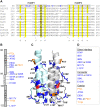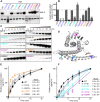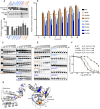Directed evolution reveals the mechanism of HitRS signaling transduction in Bacillus anthracis
- PMID: 33362282
- PMCID: PMC7790381
- DOI: 10.1371/journal.ppat.1009148
Directed evolution reveals the mechanism of HitRS signaling transduction in Bacillus anthracis
Abstract
Two component systems (TCSs) are a primary mechanism of signal sensing and response in bacteria. Systematic characterization of an entire TCS could provide a mechanistic understanding of these important signal transduction systems. Here, genetic selections were employed to dissect the molecular basis of signal transduction by the HitRS system that detects cell envelope stress in the pathogen Bacillus anthracis. Numerous point mutations were isolated within HitRS, 17 of which were in a 50-residue HAMP domain. Mutational analysis revealed the importance of hydrophobic interactions within the HAMP domain and highlighted its essentiality in TCS signaling. In addition, these data defined residues critical for activities intrinsic to HitRS, uncovered specific interactions among individual domains and between the two signaling proteins, and revealed that phosphotransfer is the rate-limiting step for signal transduction. Furthermore, this study establishes the use of unbiased genetic selections to study TCS signaling and provides a comprehensive mechanistic understanding of an entire TCS.
Conflict of interest statement
No authors have competing interests.
Figures







References
-
- Shatalin K, Gusarov I, Avetissova E, Shatalina Y, McQuade LE, Lippard SJ, et al. Bacillus anthracis-derived nitric oxide is essential for pathogen virulence and survival in macrophages. Proceedings of the National Academy of Sciences. 2008;105(3):1009–13. 10.1073/pnas.0710950105 - DOI - PMC - PubMed
Publication types
MeSH terms
Substances
Grants and funding
LinkOut - more resources
Full Text Sources

